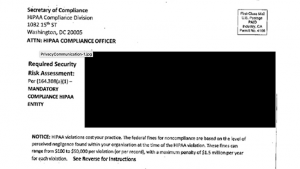
OCR warns hospitals of HIPAA compliance scams
A nonexistent “Secretary of Compliance, HIPAA Compliance Division” is mailing postcards that ask privacy and security leaders to visit a fraudulent URL for the purpose
Author(s) Scott Rose (NIST), Oliver Borchert (NIST), Stu Mitchell (Stu2Labs), Sean Connelly (DHS)

A nonexistent “Secretary of Compliance, HIPAA Compliance Division” is mailing postcards that ask privacy and security leaders to visit a fraudulent URL for the purpose

“We are empowering medical providers to serve patients wherever they are during this national public health emergency. We are especially concerned about reaching those most

https://www.youtube.com/watch?v=dBfKcTXcBss&feature=youtu.beMeet Benjamin Anderson, Founder & CEO at Wand. Serial entrepreneur and strategist with an extensive background in business development services and marketing. Started his first

Grant recipient Ben Anderson on the benefits of SafeT API and his usage of the 2019 SafeT Grant. https://www.youtube.com/watch?v=68rAOvL1VrI Apply For a SafeT Grant